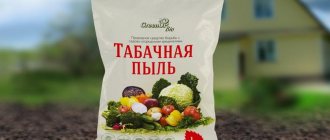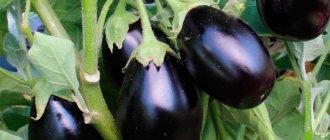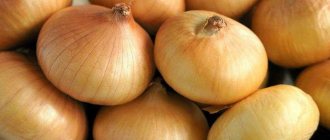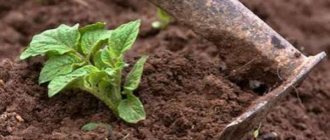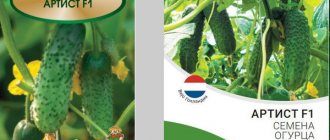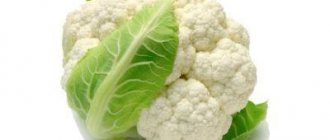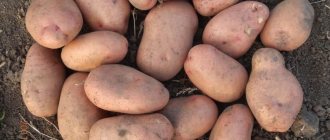Characteristics of tubers
Aurora is a mid-season variety. The period of full ripening is 60-80 days. Root vegetables are classified as table vegetables. Despite the fact that Aurora is a table variety, it stands out for its rather high yield. From one hectare you can harvest approximately 300-400 centners of excellent potatoes.
The tubers are distinguished by high commercial qualities. The average weight of potatoes is 90-130 g. Starch content is 13-17%. Root vegetables have excellent taste. Aurora is a crumbly variety that is great for making soups, purees, and casseroles. The color of the shell is yellow, the color of the pulp is cream.
The variety has excellent immunity, protecting it from most fungal diseases, except late blight. Also, Aurora adapts to any climatic conditions, thanks to which the root crop can be grown both in the Northern and Central regions of the country.
Reviews from gardeners about Aurora potatoes
Tatyana, 43 years old, Taganrog I have been growing potatoes for more than ten years. Last year I decided to try planting a new variety. For a long time I couldn’t choose something suitable until I saw a photo of Aurora potatoes. He immediately amazed me with the size of his fruits. The yield of the Aurora variety is excellent; I collected more than 20 large tubers from each bush. At the same time, the summer turned out to be hot, and I didn’t water the bushes at all.
Andrey, 60 years old, Voronezh Aurora is my favorite potato variety. I've been growing it for several years now. In all this time I have never regretted that I planted her. Of course, sometimes there were problems, and the fruits did not grow very large. However, most often the variety pleases with high yield.
Svetlana, 53 years old, Volgograd I have been growing Aurora in my dacha for a long time, I really like this variety. The fruits grow large and beautiful. I prepare various potato dishes from them and add them to soups. The harvested crop is stored for a long time, does not spoil or crack.
Landing
Only the healthiest root crops are selected for planting. There should be no cracks, stains, rot, etc. on the surface of the fruit.
Planting is carried out after the soil has warmed up to a temperature of +9 degrees Celsius. This time occurs approximately in the middle or end of May (depending on the growing area).
The standard planting pattern is 25-30 cm between holes and about 70 centimeters between rows. Planting depth is up to 15 cm. The standard planting depth is 10 cm. When grown in cold regions, the holes are made 5 cm deeper.
Aurora grows best after legumes, corn and cabbage. It is also advisable to plant potatoes in well-fertilized soil.
Description of the variety
Lina is a potato variety bred in 1978 by employees of the Siberian Research Institute of Plant Growing and Breeding. Characterized by unpretentiousness and disease resistance. High-yielding variety: up to 50 tons of potatoes are harvested from 1 hectare.
When grown, Lina potatoes produce tall, erect bushes with slightly branched and medium-leafed stems. Potatoes of this variety are characterized by long and abundant flowering. The flowers are small and white.
From the moment of emergence of seedlings to harvest, it takes from 75 to 90 days.
What is the difference from other varieties
What distinguishes Lina from other vegetable varieties is:
- high productivity;
- ease of care;
- immunity to diseases;
- insensitivity to different weather conditions.
Table. Comparison of popular potato varieties.
| Name | Ripening time, days | Yield indicator, kg per 1 hundred square meters | Tuber weight, g | Resistance to diseases and pests |
| Lina | 75–90 | 210–500 | 105—250 | Resistant to potato blight and late blight. Susceptible to golden nematode |
| Baron | 70–75 | 110—370 | 110—190 | Cancer resistant. Susceptible to late blight and scab |
| Zekura | 90–100 | 195–365 | 60—150 | Nematode resistant. Susceptible to late blight, scab, glandular spot, leafroll virus, Y and A viruses |
| Sappho | 80–90 | 180–530 | 110—230 | Moderate resistance to canker, nematode, wrinkled, banded mosaic, leaf curl |
| Varmas | 60–70 | 210—380 | 90—120 | Cancer resistant. Affected by scab, rhizoctonia, late blight |
Chemical composition, trace elements and vitamins
The Lina variety has a rich chemical composition. The pleasant taste of potatoes is due to the starch it contains (18.5%) and sugars - glucose, sucrose, fructose. Tubers have a lot of fiber. The protein content is low, less than 2%. However, it is close in composition to animal protein.
The composition contains free amino acids - about 20, in particular, essential ones.
Lina is characterized by a high content of vitamins:
- ascorbic acid;
- tocopherol;
- carotene;
- phylloquinone;
- group B.
The variety is characterized by a high content of various macro- and microelements. Tubers contain a lot of potassium, magnesium, phosphorus, iron, iodine and fluorine.
When eaten, potatoes of this variety are well absorbed by the body. Suitable for dietary purposes.
Characteristics of tubers and yield
The tubers of this variety are regular oval in shape, covered with a smooth yellow skin with a small number of eyes. The pulp is white in color. The weight of potatoes ranges from 105 to 250 g.
Lina potatoes have an attractive presentation and good keeping quality. The marketability rate is quite high - from 78 to 99%, so the variety is valued on the market.
From 7 to 11 potatoes are harvested from one bush. From 1 m² of potato planting you get from 2.1 to 5.4 kg, and from 1 hectare – up to 50 tons of crop.
Region for cultivation and planting dates
Initially, the variety was bred by breeders for cultivation in the following regions:
- North Caucasus;
- Ural;
- West Siberian;
- East Siberian;
- Far Eastern.
Today, the Lina variety is grown in all regions of the Russian Federation, including in areas with unfavorable climatic conditions. It is popular in Moscow and the Moscow region, Novosibirsk, St. Petersburg.
Potatoes are planted in open ground when the ground warms up to +8⁰C at a depth of 10 cm. Planting usually begins in mid-May.
Care
Caring for potatoes comes down to four pillars:
- Watering.
- Fertilizer.
- Hilling.
- Protection from diseases and pests.
Watering
You need to water the potatoes often, but do not overwater the tubers. Experienced gardeners recommend watering Aurora only 3 times. The first time after the tops appear (when they “peek out” 10-15 cm from the ground). The second time after the beginning of flowering and the third time before the end of flowering. After the potatoes have bloomed, it is not recommended to water the crop, as there is a risk of contracting late blight. And Aurora, by itself, has low protection against this fungus.
Fertilizer
Fertilizing potatoes is quite simple. Unlike many other crops that need to be fertilized systematically, to get a good potato harvest, it is enough to fertilize the soil only once - in the fall. Before preparing the soil for wintering, it is thoroughly loosened (plowed) and fertilized with humus. This is quite enough for Aurora to give peak birth. At the same time, it is worth limiting the amount of nitrogen-containing fertilizers in the soil. Nitrogen stimulates the growth of tops, which inhibits the development of root crops.
Hilling
Hill up the tops twice. The first time hilling procedures are carried out after the tops appear (when they reach 15-20 cm). The second time - as it grows (after about 2-3 weeks). During hilling, the area is also cleared of weeds, which negatively affect the development of root crops.
Protection from diseases and pests
As noted above, Aurora has a fairly strong immune system. The only problem that a gardener may encounter when growing this variety is late blight. To treat crops against this fungus, special fungicides are used.
As for parasites, Aurora is most often attacked by the Colorado potato beetle, mole cricket and wireworm. To combat the mole cricket and the Colorado potato beetle, you can use the good insecticide “Confidor”. To combat wireworms, the drug “Prestige” is perfect.
Ground part of the plant
Not a very important characteristic, since the root crop itself is of interest. However, without it, the Aurora potato will not receive a complete description of the variety. The plant is a tall bush. If the weather is not too hot and the soil is rich in minerals, it can be very high.
Requires regular hilling, as tall stems will fall and become deformed. Therefore it is called semi-erect. The leaves are light green, irregularly pinnate. The edge of the leaf is slightly wavy. During the flowering period, it produces a large red-violet corolla.
It should be noted that when describing the Aurora potatoes, reviews from gardeners and agricultural workers about them are always very good.
Advantages and disadvantages
The variety has gained popularity among gardeners due to its advantages, of which Aurora has more than enough. Among the main advantages it is worth noting:
- Excellent taste.
- High yield.
- High levels of immunity.
- Excellent product quality.
- Well preserved. The keeping quality of tubers reaches 94%.
We recommend reading: “Description of the Uladar potato variety”
There are few disadvantages. The main thing is low resistance to late blight and a long ripening period.
Adviсe
Aurora potatoes tolerate any climatic vagaries well. But still, with good care, the harvest will be many times better. Experienced gardeners have come up with a number of tips that will help you get a quality harvest:
- Experts recommend harrowing the soil after planting root crops in the ground. This helps increase productivity.
- Aurora is difficult to tolerate the formation of crust on the soil surface, so do not forget about loosening.
- Many gardeners note that yields increase significantly if the soil is mulched. You can use straw or hay for this.
Harvesting
Aurora potatoes are harvested 85-95 days after planting the tubers in the ground. You can determine the maturity of a potato by its tops. It should be yellowed and dried out. You need to dig up the potatoes carefully so as not to accidentally damage the fruits. The dug up potatoes are cleared of soil in advance and dried if necessary. After drying, the tubers are sorted and sent for storage.
Storage rules
The harvested Aurora potato crop must be stored in cellars or rooms at a temperature no higher than 3-5 degrees Celsius. It should be stored in wooden boxes or fabric bags. You cannot throw potatoes on the floor, as they may rot.
